How artists Jennifer and Kevin McCoy’s first collaborative NFT series recreates American landscapes with AI

Jennifer and Kevin McCoy are no strangers to an American road trip. As West Coast natives living in Brooklyn, the artist couple are seasoned off-roaders and clearly the spacious landscapes have made an impression.
Each of the 310 collages consists of Land Sea and sky, McCoy’s first collaborative NFT collection that launched on April 6 (and is now sold out), reads like a mesmerizing memory of a transcontinental journey. It’s all there—the tawny flats of the Midwest, the candy floss clouds, the cascading cliffs, the cheap roadside lodgings, the snow-capped mountains—only these aren’t sun-tinted Polaroids dug out of a shoebox and digitized, but the products of an artificial art generator .
The works begin in collage with McCoys marking shapes and forms with edges that carry a roughness, as if torn out of a magazine. For guidance, the pair pored over the photographs of Ansel Adams, the godfather of American landscape photography, noting textures and patterns that appealed.

Jennifer and Kevin McCoy, 06 Land 54 Mountains 35 Sea 37 Sky 28 Trees (2023). Photo courtesy of Artwrld and the artists.
The McCoys used stable diffusion to generate hundreds of landscapes using messages spanning all 50 states, such as “Stormy sea off the Alabama coast” or “Skies above the desert near Las Vegas.” They sorted these into one of five topographies: land, sea, sky, trees, and mountains, and then methodically filled in their carved landscapes. Finally, they animated the individual images using simple panning techniques, those that visually reproduce the experience of looking out the car window on a long drive.
To look at one of their collages is to recognize an unrecognizable landscape, to see all of America and nowhere at all.
“We’re turning our attention to the latest tools for AI image generation,” McCoys told Artnet News. “We want to make a connection between the earlier aesthetic sensibilities and the new kind of image which is essentially a statistical image, an ‘average’ image created through mathematics.”

Jennifer and Kevin McCoy, 83 Land 56 Mountains 30 Sea 26 Sky, (2023). Photo courtesy of Artwrld and the artists.
The McCoys are far from the first creatives to merge the two most vibrant phenomena in the art world – AI-generated images and NFTs – but the timing and choice of Artwrld as a platform proves the thoughtfulness behind it. Land Sea and sky. Lest it be forgotten, Kevin McCoy is widely credited with coining the first NFT, Quantum, in 2014, which later sold for $1.47 million at Sotheby’s in 2021, and the couple have often spoken about their belief in Web3 and cryptocurrency.
Despite such a pedigree, the McCoys have been sparing with their NFT drops and have now chosen to do so on a platform devoted to collaborating with artists on thoughtful projects. Artwrld has only released five projects since launching in early 2022. Each Artwrld project benefits a nonprofit of the artist’s choice, with the McCoys allocating 10 percent of primary sales and one percent of secondary says to Rhizome, an organization that promotes digital artists through assignments and grants.

Kevin McCoy, Quantum (2014). Courtesy of Sotheby’s.
This attention extends to the McCoys’ approach to AI-generated imagery, which has caused considerable turbulence due to their lack of oversight and the threat they pose to working artists.
“The rapid progress that has been made in recent years [in A.I.] hints about the effects these systems will have,” McCoys said. “Engaging with an AI model to produce a result is a very fuzzy process, even for the researchers who created the model.”
In a playful conceptual flourish, McCoys compares the opaque process by which a prompt typed into a generator creates an image to a wilderness. The goal, as the McCoys describe it, was to connect the wilderness of 21st-century image-making to the physical one American artists of the previous 200 years ventured into to paint and photograph.
The wildernesses they present are stunning and disturbing in equal measure.
Follow Artnet News on Facebook:
Do you want to be at the forefront of the art world? Subscribe to our newsletter to get the latest news, eye-opening interviews and sharp critiques that drive the conversation forward.























